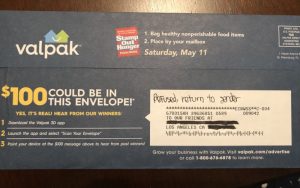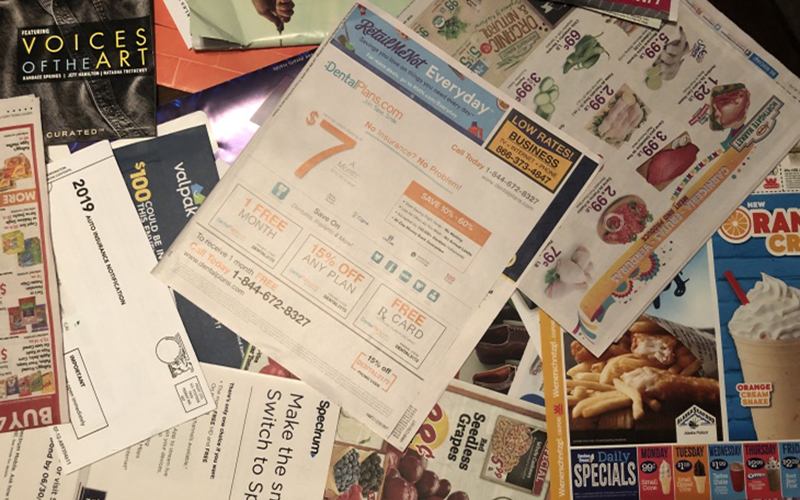LOS ANGELES – I’m that grocery shopper who pulls up to the EV charging spot, walks in with my reusable bags for the bulk section and inevitably causes confusion when I ask the butcher to put my ground turkey directly into my glass container.
Every couple weeks, I drive all my rotting banana peels and broccoli stems to a community garden 3 miles from my apartment, where they’re composted.
It takes a week for my husband and I to fill up our 2-gallon trash can and our 8-gallon recycling bin.
But despite putting so much effort into not creating waste, into being the best recycler I could be, there was one thing that I couldn’t seem to stop. Junk mail.
The 2-for-1 pizza deals, supermarket discounts and persistent credit card offers were getting out of hand. Several days a week, I’d find them crammed into my tiny apartment mailbox – which nearly exploded everytime I opened it.
The Los Angeles Department of Public Works estimates that about 100 million trees are cut down annually to make direct marketing advertisements and Americans spend an average eight months of their lives sifting through it.
And sure, recycling is great, but that paper can only get reused five to seven times before it’s not useful anymore.
My junk mail was wasting my time, the trees and somebody else’s money. I decided to embark on a quest, to go where no man had gone before – to end my junk mail for good.
So I started with some research.
Why direct mail marketing survives
In the digital age, paper mail feels old-fashioned. With all the robo-calls, spam emails and pop-ups, I figured no one even looks at their junk mail, but I was wrong.
Mark Pitts of the American Forest and Paper Association is the man in charge of any paper used for printing across the United States.
He told me that companies still use paper because it keeps customers engaged: “They call it junk mail but the reality is, people read it.”
Even in the digital age, Pitts said, paper provides the highest return on investment. And, despite the logical assumption that younger people are more averse to physical spam, it turns out that millennials engage with junk mail just as much as baby boomers.
“The millennial generation actually had better recall on print advertising,” he said, “because their attention span is very short in the digital space.”
As for how that mail ends up in any particular mailbox, Senny Boone of the Association of National Advertisers said people could be subscribers, recent purchasers or … they could just live in the right ZIP code.
“It might be that there’s a very nearby Pizza Hut in your area, so they want everyone in the area to know about it because it’s local advertising,” she said.
After speaking with the experts, it was clear that junk mail wouldn’t stop itself … but could one person stop the junk mail?
Turns out it was about as complicated as it sounds.
I decided to tackle the problem in steps, by category of junk mail, starting with the worst kind.
1. Credit card offers
Ever since I started making payments on my first credit card in college, the credit offers have kept coming. And coming.
That’s because the Fair Credit Reporting Act (FCRA) lets consumer credit report companies (TransUnion, Equifax, Experian) put names like mine on lists that creditors use to determine who they want to see their insurance and credit offers.
Enter OptOutPrescreen: the FCRA’s option to stop getting (or sign up for) those offers. You can opt out for five years by filling out a form online, or do it permanently by mailing that form to their opt-out department in Atlanta. (Editors note: Submitting your Social Security Number is optional. The opt-out request goes through with just your name and address.)
It takes five days for the consumer credit report companies to remove your name from those lists, but it might take longer for the offers to stop coming through. That’s because companies might have created offers for you that just haven’t been sent out yet.
Filling out the form probably took about 90 seconds.
2. Catalogs
These are the Postmates and Walgreens deals that arrive at your house via flyers, or actual catalogs, for the online-shopping averse.
The hard way to get rid of this kind of junk mail means contacting each company individually.
I took the easy way and signed up for DMAchoice, which is the closest thing to a one-stop junk-mail stopper the internet has to offer. There, I took my name off catalog and magazine lists, and unsubscribed from hundreds of other companies’ offers.
All that convenience only cost me a $2 processing fee. And the website says I’ll stay off the mailing lists for 10 years.
The Association of National Advertisers now owns the DMAchoice service. Boone said the service was born after the industry decided in the 1970s that consumers should be able to reduce unwanted mail.
“Certainly from the consumer’s perspective they don’t want to get unwanted mail that’s not relevant to them,” he said. “For the business side, they don’t want to send mail to people that don’t want it because there’s a cost there.”
Boone said once consumers register, their name is added to a suppression file that businesses can access when they’re getting ready for their next campaign.
Unsubscribing from the suppression file took two minutes to do. But I haven’t seen results here yet – DMA says it could take as many as 90 days to stop receiving those offers.
3. Bills, bill, bills
For years now I’ve gotten credit card statements and utility bills in the mail. This might not count as junk mail, but it was still going into my recycling bin unopened, because I found it easier to pay online.
It turns out that all of the companies that bill me have an option to go paperless. A 10-minute search through account settings and FAQ pages provided the instant gratification I was looking for.
After my next billing cycle, I shouldn’t get any more of these. Victory!
4. Return to sender

Writing “Return to sender” or “Not at this address” on envelopes that aren’t addressed directly to you can sometimes do the trick. (Photo by Caleigh Wells/LAist)
Now we start entering the more time-consuming battle of the junk mail war. But it’s worth the effort – this has definitely been the most satisfying part of cleaning up my mailbox.
I found out that you can throw envelopes right back into the mailbox, and write “Refused, return to sender” on them, if those envelopes say one of the following phrases:
● Return service requested
● Forwarding service requested
● Address service requested
● Change service requested
You can also write “Return to sender” or “Not at this address” for any mail addressed to someone else (and if you live in an apartment like I do, that makes up a significant chunk of junk mail).
Another victory.
5. Loose ends
There are still companies that have used other resources to get my address. I’ve signed up for more than one mailing list in my life to get 15% off my first order. I still get alumni magazines, and my alma mater likes to remind me that it’s always willing to take more donations before the fiscal year ends.
But I found a (possible) solution. A simple Google search led me to PaperKarma, a free phone app that claims to make unsubscribing easy. The user takes a photo of the unwanted mail, types in their name and address and hits the unsubscribe button. Then the app gets it done in the next business day.
The app will unsubscribe from four services for free. After that, I’d have to pay $2 a month or $20 per year for unlimited unsubscribe requests, which I’m not willing to do – yet.
PaperKarma’s app also says it still takes one to three mail cycles before the unsubscribes start working, so I’m still waiting to see results.
Conclusions?
The short answer is … maybe?
A week later, the credit card offers have definitely slowed down and the paperless bills are soon to be history.
As for the catalogs and donation requests, the jury’s still out. I hear some companies are more challenging to break up with than others.
So if you really want to know if my attempt was a success, ask me in two months.
This story is part of Elemental: Covering Sustainability, a new multimedia collaboration between Cronkite News, Arizona PBS, KJZZ, KPCC, Rocky Mountain PBS and PBS SoCal.
AlertMe
